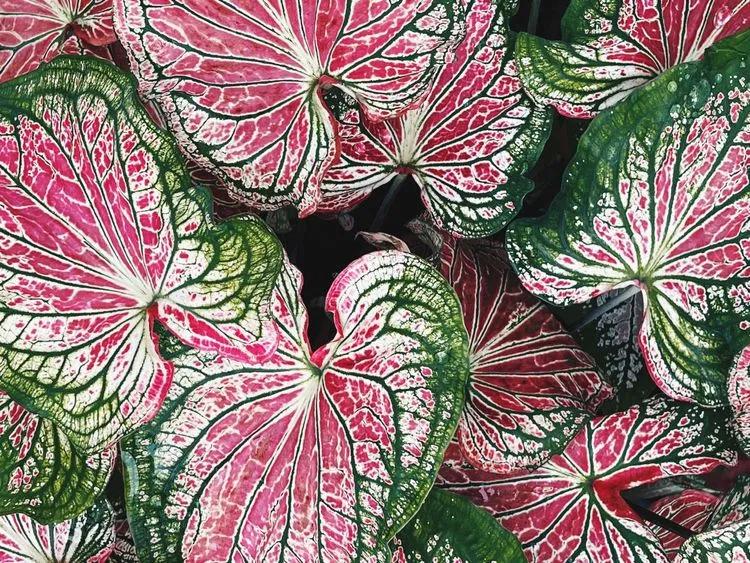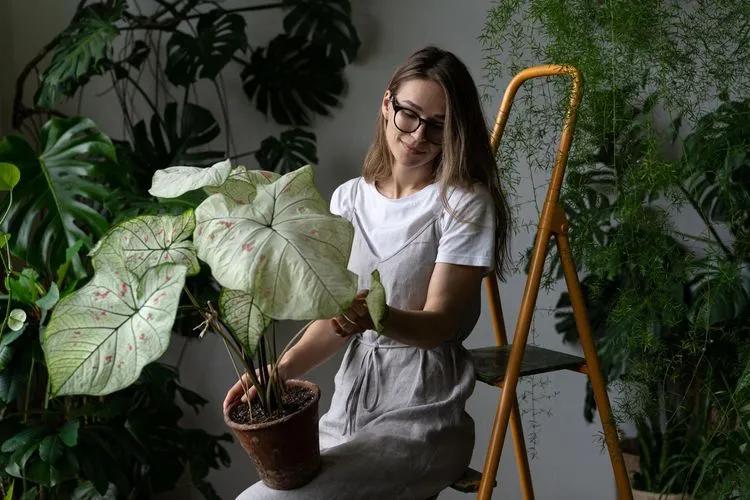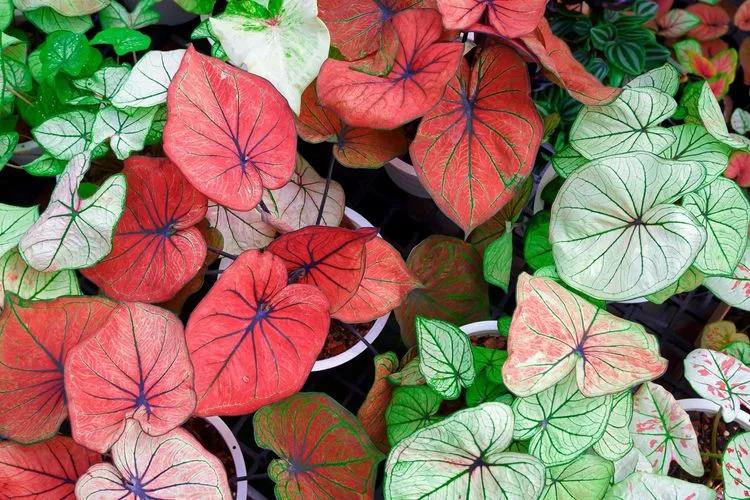This plant is mainly known as Heart of Jesus or caladium. It also has several common names, including Elephant ears or Angel wings due to its specific shape can remind heart, wings, or even ears. Caladium can boast with its stunning foliage: let’s get to know all the preferences of this cutie!

Overview
These plants are admired for their beauty, and as was mentioned above, their leaves have recognizable shapes. Also, they are whimsically colored, usually a mix of pink and green or white with notable green inclusions. These plants are originated from South America, so they need a decent amount of sun and water. Of course, many plant varieties differ depending on size or colors, but no doubt all of them are equally pretty. Since they are from the Araceae family, they are considered blooming plants. Their flowers are not as spectacular as their leaves, but they still are attractive. They look like a bud (primarily white), simple but exquisite despite not having distinct petals.
Watering

These plants aren’t picky. To keep your plant alive and healthy, you need to water it regularly, approximately once a week. In their growing periods, they need more regular watering. When you water your plant, the very first thing you need to pay attention to dryness of the soil. If the top layer is dry, then go on! This plant needs water! But otherwise don’t bother it, because overwatering can be bad for plant’s condition. Typical symptoms of overwatering, such as yellowing or curling leaves, may occur; also, it can cause root rot.
Temperature

The most suitable temperature for caladiums is 15°C-21°C (59°F-70°F). These plants depend on warm temperatures, and it can be dangerous if it is too cold. The heart of Jesus can grow indoors and outdoors; in this case, you need to remember that you can plant it outside only when the soil temperature is at least 21°C (70 °F).
Speaking of low temperatures, these plants won’t be safe outside in winter in most climates, so you should keep it somewhere warm, for example, in house or storage. But in mild climates, where the average temperature remains about 7°C (45 °F), overwintering outdoors is possible; you need to pay more attention to your plant. You need to remove naturally fallen leaves during this period and cover the plant with a ‘blanket’ made from straws or bark. The size of such cover should be 5-10 cm (2-4 inches). This procedure will help to keep soil in good condition and to prevent damages and freezing.
Light
With these plants, you should avoid direct sunlight, notably in warmer seasons. But it doesn’t mean you should place your caladium in some dark corner because it can weaken the plant. First of all, lousy placement affects its pigmentation – the plant can lose its colors, so there will be only green instead of two colors. The plant enjoys bright but indirect sunlight; it affects its growth very well.
Pretty, yet dangerous

Bright colors are usually a clue that something is toxic. It works with the heart of Jesus. Due to the containment of calcium oxalate crystals, these plants are considered poisonous, particularly for humans and pets. If you touch the plant’s sap, it can cause skin irritation. Also, it’s pretty reckless to consume the juice because it provokes burning of lips and tongue. But soon, you will feel nauseous; it can lead to such symptoms as vomiting and diarrhea. Thus, it is better to keep the plant away from children and pets.
Other Recommendations
Which soil to choose? The best soil for the heart of Jesus should be well-drained, and it should be full of organic matters, such as composted leaves, etc. Give a preference to universal or premium potting mixes.
How much fertilizer does it need? These plants don’t require a lot of fertilizer; in fact, too much of it can damage the plant. You can use liquid fertilizer or a controlled-release one.
How to choose the pot? The pot size needs to be twice as large as tubers; for example, for a tuber of about 5 cm (1 inch), you will need a pot of about 10-12 cm (3-7 inches).
How to prevent diseases? Since caladiums grow from tubers, the tubers are the first ones to be attacked by diseases, usually caused by fungus. To avoid such a problem, drench tubers in hot water (about 50°C (122°F) before planting to kill fungus, check if it’s dry, and finally plant it.
FAQ
What Is the Heart of Jesus Plant Used For?
The Heart of Jesus plant (Caladium) is mostly grown for its beautiful, heart-shaped leaves. While some traditional remedies use it, all parts are toxic, so it’s best appreciated for its stunning foliage rather than eaten or applied to the body.
